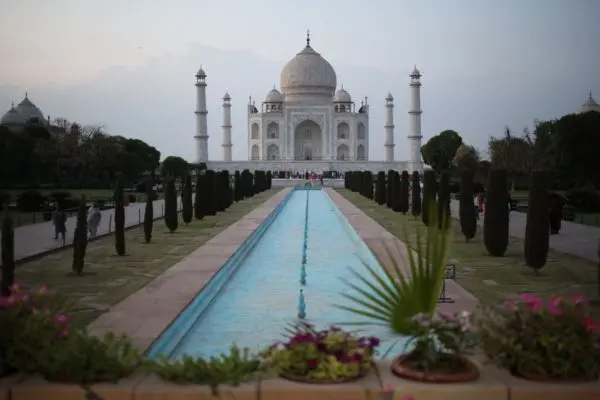Nestled on the banks of the Yamuna River in Agra, India, the Taj Mahal stands as a testament to enduring love and architectural brilliance. This iconic monument, often heralded as one of the New Seven Wonders of the World, attracts millions of visitors annually who come to marvel at its beauty and history.
A Love Story Etched in Marble
The Taj Mahal was commissioned by Mughal Emperor Shah Jahan in memory of his beloved wife, Mumtaz Mahal. The story goes that Mumtaz Mahal, on her deathbed, asked her husband to build a monument that would symbolize their eternal love. Grief-stricken but determined, Shah Jahan set about creating what would become one of the most beautiful buildings in the world. Construction began in 1632 and was completed in 1653, involving thousands of artisans and craftsmen from across the empire.
Architectural Marvel
The Taj Mahal is a masterpiece of Mughal architecture, combining elements from Islamic, Persian, Ottoman Turkish, and Indian architectural styles. Its most striking feature is the gleaming white marble dome, which reaches a height of 73 meters (240 feet). The main mausoleum is flanked by four minarets, each standing 40 meters (130 feet) tall, designed to lean slightly outward to protect the tomb in case of an earthquake.
Intricate carvings, calligraphy, and inlay work adorn the entire structure. The pietra dura technique, which uses precious and semi-precious stones to create floral and geometric patterns, adds to the building’s ethereal beauty. The central chamber houses the cenotaphs of Shah Jahan and Mumtaz Mahal, although their actual graves lie in a lower chamber.
Gardens of Paradise
The Taj Mahal is set amidst a vast Mughal garden, known as the Charbagh, which is divided into four quadrants by water channels. This garden layout is symbolic of the Islamic concept of paradise, with lush greenery, reflecting pools, and fountains enhancing the serene ambiance. The reflection of the Taj Mahal in the long pool of water in front of it creates a breathtaking sight, especially during sunrise and sunset.
Preservation and Challenges
Over the centuries, the Taj Mahal has faced numerous challenges, including pollution, environmental degradation, and the impact of mass tourism. The Indian government and various international organizations have undertaken extensive preservation efforts to protect this UNESCO World Heritage site. Measures such as limiting vehicle emissions near the monument, restoring the marble facade, and managing tourist access have been implemented to ensure its longevity.
Visiting the Taj Mahal
A visit to the Taj Mahal is an unforgettable experience. To fully appreciate its beauty, plan to arrive early in the morning to witness the sunrise, when the first rays of light bathe the marble in a soft, golden hue. Alternatively, the monument looks equally mesmerizing under the moonlight. private driver delhi to agra .
When visiting, remember to dress modestly and be respectful of the site’s cultural and historical significance. Photography is allowed in certain areas, but be mindful of the rules and other visitors.
Conclusion
The Taj Mahal is more than just a monument; it is a symbol of love, a masterpiece of architecture, and a piece of history that continues to inspire awe and wonder. Whether you are an avid traveler, a history enthusiast, or a romantic at heart, the Taj Mahal is a destination that promises to leave a lasting impression.
Plan your visit, and be prepared to be captivated by the timeless beauty of the Taj Mahal with Private Driver Delhi to Agra


